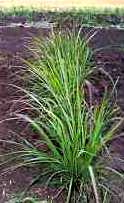View crop
View crop Data sheet EcoPortCymbopogon citratus
 |
|
| Notes |
|---|
| BRIEF DESCRIPTION A tall, densely tufted grass with numerous stiff stems arising from short rhizomatous rootstocks reaching up to 120 cm in height. The leaves are grasslike, drooping, 50-100 cm long and about 1.25 cm wide. It seldom flowers USES An essential oil is obtained from the leaves and used in insect repellents, for flavoring soft drinks, foods, and in scenting soaps, various technical preparations, perfumes, and cosmetics. It is also used in the synthesis of vitamin A. The grass is useful for soil improvement and erosion control. GROWING PERIOD Perennial. Harvesting begins when the crop is 120-240 days old, and it is subsequently harvested every 90-120 days. Economical life 4 years. COMMON NAMES West Indian lemongrass, Sere grass, Lemon grass, Citronnelle, Fever grass, Ce kala, Nche awuta, Ahihia tii, Hhashel laymum, Koriko oyibo, Koko oba. FURTHER INF Scientific synonym: Andropogon citratus, A. ceriferus, A. nardus var. Ceriferus. West Indian lemongrass is probably native of Sri Lanka or Malaysia, but it is not known in a wild state. Fresh grass yields 0.2-0.4% oil, with an average yield of 50-120 kg oil/ha per annum. Yield of foliage is higher on fertile heavy soils, but under these conditions the oil usually has a lower citral content. Mentioned as a useful agroforestry species. | Sources |
| Grassland Index - In Ecocrop as synonym Cymbopogon citratus Purseglove J 1972 pp 137-138 [LIG, RAIN, FER, TEXT, USE] Roecklein J 1987 pp 109 [USE] Duke J 1975 pp 14 [PH, RAIN, TEMP] Nair P 1980 pp 312-313 [USE, TEMP, DRA, FER, TEXT] Iwu M 1993 pp 166-167 [USE, TEMP, LIG] |